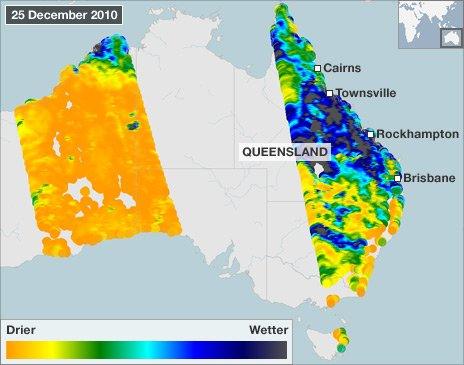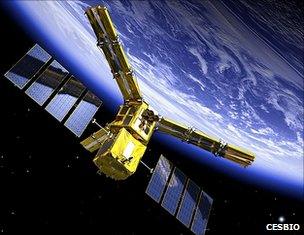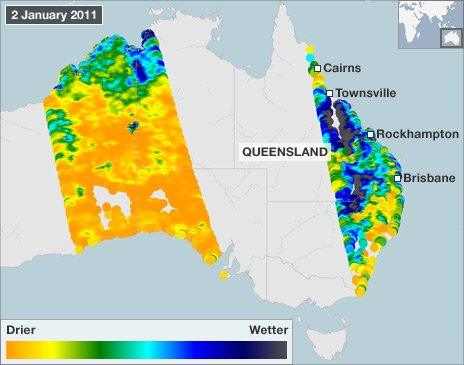Queensland's soggy soils revealed
- Published

Smos passes over Australia twice a day, producing broad strips of imagery
The extent to which Queensland's soils became saturated with water as the Australian state was deluged with rain is evident in new satellite imagery.
The maps were made by Europe's Smos spacecraft, which carries a novel instrument capable of seeing the moisture held in the ground.
Launched in 2009, the satellite is on an experimental mission.
The hope is that its data can be used in future to give flood warnings where wet soils are becoming overloaded.
"This is what we want to do," explained Dr Claire Gruhier, a Smos researcher from the Centre for Spatial Studies of the Biosphere (Cesbio) in Toulouse, France.
"We are working on techniques that will allow us to combine the soil moisture product of Smos with the precipitation information from other satellites."
The floods in Queensland have been among the worst ever recorded in the state.

"Space chopper": The Smos radiometer makes the satellite look like a helicopter
They have left a vast area under water, inundated 30,000 homes and businesses and claimed the lives of at least 30 people.
Maps made by the European Space Agency Smos satellite document the state's increasingly soggy ground at the height of the natural disaster.
The first image records the spacecraft's two passes over Australia on 25 December, when Tropical Cyclone Tasha was battering the Queensland coast.
The wet earth in the north-east of the continent contrasts dramatically with the dry ground in central-west Australia.
Darker blue colours denote soils that contain more than 40% water.
In the week 22-28 December, some areas were experiencing more than 300 or 400 mm of precipitation.
At that rate, the earth will rapidly saturate and any excess liquid will simply run off.

Darker blue colours denote soils that contain more than 40% water
The second map shows Smos data from 2 January, the day before the activation of the International Charter [on] Space and Disasters.
This charter coordinates Earth observation satellites from many nations to provide imagery to support emergency services and aid organisations.
In this instance, the request for help was initiated by charter member USGS (US Geological Survey) on behalf of Emergency Management Australia.

There comes a point when the soil can no longer hold anymore water and excess liquid runs off
The latest imagery from Smos illustrates the satellite's potential to deliver more timely flood warnings.
If its data is tied together with precipitation forecasts, it could be used to assess which locations are most at risk.
Smos carries a single instrument: an 8m-wide interferometric radiometer.
This instrument works by measuring the natural emission of microwaves coming up off the planet's surface.
Variations in the sogginess of the soil will modify this signal.
Smos stands for Soil Moisture and Ocean Salinity, external. The radiometer will also measure variations in the saltiness of seawater.
The investigation of Smos soil moisture data is led from Cesbio, external.
- Published17 January 2011
- Published30 June 2010